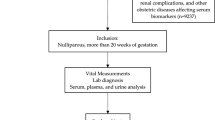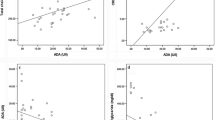Abstract
Background
Advanced glycation end products (AGEs) are major risk factors for vascular complications in diabetes. Its role in gestational diabetes mellitus (GDM) and vascular complications in GDM is not known.
Objective
The present study was aimed to study the association of AGEs with GDM and vascular inflammation.
Methods
Plasma samples from normal pregnant and GDM women (n = 50 each) were obtained from two tertiary referral centers in Tamil Nadu, India. Quantification of AGEs, methylglyoxal (MGO), ICAM-1, and malondialdehyde (MDA) were performed by commercially available ELISA kits.
Results and conclusions
The third trimester fasting blood sugar (101.35 ± 26.15 vs. 81.63 ± 6.14, p < 0.002) and postprandial blood sugar (150.69 ± 23.07 vs 105.79 ± 11.99, p < 0.0001) were significantly high in GDM women compared to normal pregnant women. The concentrations of AGEs (13.18 ± 8.74, p < 0.001), MGO (15.7 ± 13.54, p < 0.02), and ICAM-1 (217.8 ± 86.92, p = 0.005) were significantly higher in GDM women compared to AGEs (2.68 ± 0.89), MGO (9.26 ± 5.38), and ICAM-1 (142.3 ± 38.21) in normal pregnant women. Further, elevated levels of MDA concentration (0.64 ± 0.08, p < 0.002) and low GSH levels (0.19 ± 0.1, p < 0.0001) in the GDM women were indicative of oxidative stress. AGE levels significantly correlated with MDA concentration which indicates AGEs may be responsible for oxidative stress in GDM women. Further, elevated level of ICAM-1 in GDM women suggests endothelial activation which may impact endothelial function. Thus, AGEs may be used as a biomarker during pregnancy to predict vascular complications due to GDM.
Similar content being viewed by others
Abbreviations
- GDM:
-
gestational diabetes mellitus
- AGEs:
-
advanced glycation end products
- MGO:
-
methylglyoxal
- MDA:
-
malondialdehyde
- ICAM-1:
-
intercellular adhesion molecule-1
- GSH:
-
glutathione reduced
- BMI:
-
body mass index
- FBS:
-
fasting blood sugar
- PPBS:
-
postprandial blood sugar
References
Seshiah V, Balaji V, Balaji MS, Sanjeevi CB, Green A. Gestational diabetes mellitus in India. J Assoc Physicians India. 2004;52:707–11.
Damm P, Houshmand-Oeregaard A, Kelstrup L, Lauenborg J, Mathiesen ER, Clausen TD. Gestational diabetes mellitus and long-term consequences for mother and offspring: a view from Denmark. Diabetologia. 2016;59(7):1396–9. https://doi.org/10.1007/s00125-016-3985-5.
Booth AA, Khalifah RG, Todd P, Hudson BG. In vitro kinetic studies of formation of antigenic advanced glycation end products (AGEs) novel inhibition of post-Amadori glycation pathways. J Biol Chem. 1997;272(9):5430–7. https://doi.org/10.1074/jbc.272.9.5430.
Brownlee M, Vlassara H, Cerami A. Nonenzymatic glycosylation and the pathogenesis of diabetic complications. Ann Intern Med. 1984;101(4):527–37. https://doi.org/10.7326/0003-4819-101-4-527.
Forbes JM, Thallas V, Thomas MC, Founds HW, Burns WC, Jerums G, et al. The breakdown of preexisting advanced glycation end products is associated with reduced renal fibrosis in experimental diabetes. FASEB J. 2003;17(12):1762–4. https://doi.org/10.1096/fj.02-1102fje.
Wendt T, Bucciarelli L, Qu W, Lu Y, Yan SF, Stern DM, et al. Receptor for advanced glycation end products (RAGE) and vascular inflammation: insights into the pathogenesis of macrovascular complications in diabetes. Curr Atheroscler Rep. 2002;4(3):228–37.
Bierhaus A, Hofmann MA, Ziegler R, Nawroth PP. AGEs and their interaction with AGE-receptors in vascular disease and diabetes mellitus. I. The AGE concept. Cardiovasc Res. 1998;37(3):586–600. https://doi.org/10.1016/s0008-6363(97)00233-2.
Loughlin DT, Artlett CM. Precursor of advanced glycation end products mediates ER-stress-induced caspase-3 activation of human dermal fibroblasts through NAD(P)H oxidase 4. PLoS One. 2010;5(6):e11093. https://doi.org/10.1371/journal.pone.0011093.
Wautier JL, Zoukourian C, Chappey O, Wautier MP, Guillausseau PJ, Cao R, et al. Receptor-mediated endothelial cell dysfunction in diabetic vasculopathy. Soluble receptor for advanced glycation end products blocks hyperpermeability in diabetic rats. J Clin Invest. 1996;97(1):238–43. https://doi.org/10.1172/JCI118397.
Yamagishi S, Nakamura N, Suematsu M, Kaseda K, Matsui T. Advanced glycation end products: a molecular target for vascular complications in diabetes. Mol Med. 2015;21(Suppl 1):S32–40. https://doi.org/10.2119/molmed.2015.00067.
Ueda S, Yamagishi S, Yokoro M, Okuda S. Role of asymmetric dimethylarginine in cardiorenal syndrome. Curr Pharm Des. 2014;20(14):2448–55.
Ojima A, Ishibashi Y, Matsui T, Maeda S, Nishino Y, Takeuchi M, et al. Glucagon-like peptide-1 receptor agonist inhibits asymmetric dimethylarginine generation in the kidney of streptozotocin-induced diabetic rats by blocking advanced glycation end product-induced protein arginine methyltranferase-1 expression. Am J Pathol. 2013;182(1):132–41. https://doi.org/10.1016/j.ajpath.2012.09.016.
Ando R, Ueda S, Yamagishi S, Miyazaki H, Kaida Y, Kaifu K, et al. Involvement of advanced glycation end product-induced asymmetric dimethylarginine generation in endothelial dysfunction. Diab Vasc Dis Res. 2013;10(5):436–41. https://doi.org/10.1177/1479164113486662.
Litwinoff E, Hurtado Del Pozo C, Ramasamy R, Schmidt AM. Emerging targets for therapeutic development in diabetes and its complications: the RAGE signaling pathway. Clin Pharmacol Ther. 2015;98(2):135–44. https://doi.org/10.1002/cpt.148.
Rabbani N, Thornalley PJ. Methylglyoxal, glyoxalase 1 and the dicarbonyl proteome. Amino Acids. 2012;42(4):1133–42. https://doi.org/10.1007/s00726-010-0783-0.
Dupont WD, Plummer WD Jr. Power and sample size calculations for studies involving linear regression. Control Clin Trials. 1998;19(6):589–601.
International Association of Diabetes and Pregnancy Study Groups Consensus Panel, Metzger BE, Gabbe SG, et al. International association of diabetes and pregnancy study groups recommendations on the diagnosis and classification of hyperglycemia in pregnancy. Diabetes Care. 2010;33(3):676–82. https://doi.org/10.2337/dc09-1848.
Deepa M, Pradeepa R, Rema M, Mohan A, Deepa R, Shanthirani S, et al. The Chennai Urban Rural Epidemiology Study (CURES)- study design and methodology (urban component) (CURES-1). J Assoc Physician India. 2003;51:863–70.
Kelstrup L, Damm P, Mathiesen ER, Hansen T, Vaag AA, Pedersen O, et al. Insulin resistance and impaired pancreatic β-cell function in adult offspring of women with diabetes in pregnancy. J Clin Endocrinol Metab. 2013 Sep;98(9):3793–801. https://doi.org/10.1210/jc.2013-1536.
Luo ZC, Fraser WD, Julien P, Deal CL, Audibert F, Smith GN, et al. Tracing the origins of “fetal origins” of adult diseases: programming by oxidative stress? Med Hypotheses. 2006;66(1):38–44. https://doi.org/10.1016/j.mehy.2005.08.020.
Lappas M, Hiden U, Desoye G, Froehlich J, Hauguel-de Mouzon S, Jawerbaum A. The role of oxidative stress in the pathophysiology of gestational diabetes mellitus. Antioxid Redox Signal. 2011;15(12):3061–100. https://doi.org/10.1089/ars.2010.3765.
Rajaraman B, Ramadas N, Krishnasamy S, Ravi V, Pathak A, Devasena CS, et al. Hyperglycaemia cause vascular inflammation through advanced glycation end products/early growth response-1 axis in gestational diabetes mellitus. Mol Cell Biochem. 2019;456(1–2):179–90. https://doi.org/10.1007/s11010-019-03503-0.
Spranger J, Kroke A, Möhlig M, Hoffmann K, Bergmann MM, Ristow M, et al. Inflammatory cytokines and the risk to develop type 2 diabetes: results of the prospective population-based European Prospective Investigation into Cancer and Nutrition (EPIC)-Potsdam Study. Diabetes. 2003;52(3):812–7. https://doi.org/10.2337/diabetes.52.3.812.
Monnier VM, Sell DR, Genuth S. Glycation products as markers and predictors of the progression of diabetic complications. Ann N Y Acad Sci. 2005;1043:567–81. https://doi.org/10.1196/annals.1333.065.
Sampathkumar R, Balasubramanyam M, Rema M, Premanand C, Mohan V. A novel advanced glycation index and its association with diabetes and microangiopathy. Metabolism. 2005;54(8):1002–7. https://doi.org/10.1016/j.metabol.2005.02.017.
Anitha B, Sampathkumar R, Balasubramanyam M, Rema M. Advanced glycation index and its association with severity of diabetic retinopathy in type 2 diabetic subjects. J Diabetes Complicat. 2008;22(4):261–6. https://doi.org/10.1016/j.jdiacomp.2007.05.005.
Gokulakrishnan K, Deepa R, Sampathkumar R, Balasubramanyam M, Mohan V. Association of leukocyte count with varying degrees of glucose intolerance in Asian Indians: the Chennai Urban Rural Epidemiology Study (CURES-26). Metab Syndr Relat Disord. 2009;7(3):205–10. https://doi.org/10.1089/met.2008.0024.
Uribarri J, Cai W, Woodward M, Tripp E, Goldberg L, Pyzik R, et al. Elevated serum advanced glycation endproducts in obese indicate risk for the metabolic syndrome: a link between healthy and unhealthy obesity? J Clin Endocrinol Metab. 2015;100(5):1957–66. https://doi.org/10.1210/jc.2014-3925.
Mericq V, Piccardo C, Cai W, Chen X, Zhu L, Striker GE, et al. Maternally transmitted and food-derived glycotoxins a factor preconditioning the young to diabetes? Diabetes Care. 2010;33(10):2232–7. https://doi.org/10.2337/dc10-1058.
Miyazawa N, Abe M, Souma T, Tanemoto M, Abe T, Nakayama M, et al. Methylglyoxal augments intracellular oxidative stress in human aortic endothelial cells. Free Radic Res. 2010;44(1):101–7. https://doi.org/10.3109/10715760903321788.
Yan SD, Schmidt AM, Anderson GM, Zhang J, Brett J, Zou YS, et al. Enhanced cellular oxidant stress by the interaction of advanced glycation end products with their receptors/binding proteins. J Biol Chem. 1994;269(13):9889–97.
Wautier MP, Chappey O, Corda S, Stern DM, Schmidt AM, Wautier JL. Activation of NADPH oxidase by AGE links oxidant stress to altered gene expression via RAGE. Am J Physiol Endocrinol Metab. 2001;280(5):E685–94.
Jialal I, Devaraj S, Venugopal SK. Oxidative stress, inflammation, and diabetic vasculopathies: the role of alpha tocopherol therapy. Free Radic Res. 2002;36(12):1331–6.
Morgan PE, Dean RT, Davies MJ. Inactivation of cellular enzymes by carbonyls and protein-bound glycation/glycoxidation products. Arch Biochem Biophys. 2002;403(2):259–69.
Deuther-Conrad W, Loske C, Schinzel R, Dringen R, Riederer P, Münch G. Advanced glycation endproducts change glutathione redox status in SH-SY5Y human neuroblastoma cells by a hydrogen peroxide dependent mechanism. Neurosci Lett. 2001;312(1):29–32. https://doi.org/10.1016/s0304-3940(01)02174-7.
Neumann A, Schinzel R, Palm D, Riederer P, Münch G. High molecular weight hyaluronic acid inhibits advanced glycation endproduct-induced NF-kappaB activation and cytokine expression. FEBS Lett. 1999;453(3):283–7. https://doi.org/10.1016/s0014-5793(99)00731-0.
Basta G, Schmidt AM, De Caterina R. Advanced glycation end products and vascular inflammation: implications for accelerated atherosclerosis in diabetes. Cardiovasc Res. 2004;63(4):582–92. https://doi.org/10.1016/j.cardiores.2004.05.001.
Kautzky-Willer A, Fasching P, Jilma B, Waldhäusl W, Wagner OF. Persistent elevation and metabolic dependence of circulating E-selectin after delivery in women with gestational diabetes mellitus. J Clin Endocrinol Metab. 1997;82(12):4117–21.
Sultan SA, Liu W, Peng Y, Roberts W, Whitelaw D, Graham AM. The role of maternal gestational diabetes in inducing fetal endothelial dysfunction. J Cell Physiol. 2015;230(11):2695–705. https://doi.org/10.1002/jcp.24993.
Poniedziałek-Czajkowska E, Mierzyński R, Szymula D, Leszczyńska-Gorzelak B, Oleszczuk J. Intercellular adhesion molecule and endogenous NOS inhibitor: asymmetric dimethylarginine in pregnant women with gestational diabetes mellitus. J Diabetes Res. 2016;2016:1342643. https://doi.org/10.1155/2016/1342643.
Funding
This study was supported by the DST–Fast track scheme by Ministry of Science and Technology, India (Grant No. SB/FT/LS-432-2012) and TRR funded by SASTRA deemed to be University awarded to Dr. Srinivasan Vedantham, Senior Assistant Professor, School of Chemical and Biotechnology, SASTRA Deemed to be University, Thanjavur, Tamil Nadu, India.
Author information
Authors and Affiliations
Corresponding authors
Ethics declarations
Conflict of interest
The authors declare that they have no conflict of interest.
Ethical approval
All procedures performed in studies involving human participants were in accordance with the ethical standards of the institutional and/or national research committee and with the 1964 Helsinki declaration and its later amendments or comparable ethical standards. Ethical committee approval (EC/AP/423/12/2015 & MCRC.IEC#001, 2015) and written informed consent were obtained from all study participants.
Additional information
Publisher’s note
Springer Nature remains neutral with regard to jurisdictional claims in published maps and institutional affiliations.
Electronic supplementary material
ESM 1
(PDF 156 kb)
Rights and permissions
About this article
Cite this article
Krishnasamy, S., Rajaraman, B., Ravi, V. et al. Association of advanced glycation end products (AGEs) with endothelial dysfunction, oxidative stress in gestational diabetes mellitus (GDM). Int J Diabetes Dev Ctries 40, 276–282 (2020). https://doi.org/10.1007/s13410-019-00766-7
Received:
Accepted:
Published:
Issue Date:
DOI: https://doi.org/10.1007/s13410-019-00766-7




